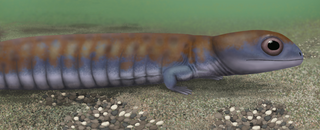| Limnerpeton Temporal range: Late Carboniferous, | |
|---|---|
| Scientific classification | |
| Kingdom: | |
| Phylum: | |
| Class: | |
| Order: | |
| Suborder: | † Euskelia |
| Superfamily: | |
| Family: | |
| Genus: | †Limnerpeton Fritsch, 1881 |
| Binomial name | |
| †Limnerpeton modestum Fritsch, 1881 | |
Limnerpeton is an extinct genus of dissorophoidean euskelian temnospondyl within the family Amphibamidae.
Limnerpeton is currently restricted to the type species L. modestum, which is dubious but represents an amphibamid. The nominal species "Limnerpeton" laticeps was later assigned to the trematopid Mordex but has been placed in a separate trematopid genus Mattauschia following Milner (2018). The nominal species L." macrolepis was synonymized with laticeps by Milner and Sequeira (2003) and Milner (2018). [1] [2] "Limnerpeton" elegans was reassigned to Micromelerpetontidae and renamed Limnogyrinus by Milner (1986). [3] "Limnerpeton" caducus is a junior synonym of Oestocephalus , while "Limnerpeton" obtusatum was synonymized with Microbrachis by Carroll and Gaskill (1978). [4]

Dissorophidae is an extinct family of medium-sized, temnospondyl amphibians that flourished during the late Carboniferous and early Permian periods. The clade is known almost exclusively from North America.

Temnospondyli is a diverse order of small to giant tetrapods—often considered primitive amphibians—that flourished worldwide during the Carboniferous, Permian, and Triassic periods. A few species continued into the Jurassic and Cretaceous periods. Fossils have been found on every continent. During about 210 million years of evolutionary history, they adapted to a wide range of habitats, including freshwater, terrestrial, and even coastal marine environments. Their life history is well understood, with fossils known from the larval stage, metamorphosis, and maturity. Most temnospondyls were semiaquatic, although some were almost fully terrestrial, returning to the water only to breed. These temnospondyls were some of the first vertebrates fully adapted to life on land. Although temnospondyls are considered amphibians, many had characteristics, such as scales and armour-like bony plates, that distinguish them from modern amphibians (lissamphibians).

Dendrerpeton is a genus of an extinct group of temnospondyl amphibians. Its fossils have been found primarily in the Joggins Formation of Eastern Canada and in Ireland. It lived during the Carboniferous and is said to be around 309–316 million years of age, corresponding to more specifically the Westphalian (stage) age. Of terrestrial temnospondyl amphibians evolution, it represents the first stage. Although multiple species have been proposed, the species unanimously recognized is D. acadianum. This species name comes from “Acadia” which is the name for ancient Indian Nova Scotia. It refers to the location of the coal field at which the fossil was found.

Capetus is an extinct genus of temnospondyl from the Upper Carboniferous of the Czech Republic. It reached a length of 150 cm.

Acheloma is an extinct genus of temnospondyl that lived during the Early Permian. The type species is A. cumminsi.
Micromelerpetontidae is an extinct family of dissorophoid temnospondyl amphibians that lived from the Late Carboniferous to the Early Permian in what is now Europe, with one Carboniferous species also known from North Africa. They were biologically similar to the related branchiosaurids, but proportionally akin to the unrelated microsaurs.

Trematopidae is a family of dissorophoid temnospondyl spanning the late Carboniferous to the early Permian. Together with Dissorophidae, the family forms Olsoniformes, a clade comprising the medium-large terrestrial dissorophoids. Trematopids are known from numerous localities in North America, primarily in New Mexico, Oklahoma, and Texas, and from the Bromacker quarry in Germany.
Actiobates is an extinct genus of trematopid temnospondyl that lived during the Late Carboniferous. It is known from the Garnett Quarry in Kansas.

Acroplous is an extinct genus of dvinosaurian Temnospondyli within the family Eobrachyopidae.

Ecolsonia is an extinct genus of trematopid temnospondyl. Its phylogenetic position within Olsoniformes has been historically debated, but it is presently considered to be a trematopid.
Kourerpeton is an extinct genus of dvinosaurian temnospondyl. Fossils of Kourerpeton were discovered in a window of a barber's shop in either Bisbee or Mesa, Arizona. Kourerpeton was named in 1976, with the type and only species being K. bradyi. It was originally assigned to the monotypic family Kourerpetidae, which has been alternatively spelled Kourerpetontidae.

Odonterpeton is an extinct genus of microsaur It is known from a single specimen found in Late Carboniferous coal measures in Ohio. It is now considered to be a member of the "microsaur" clade Recumbirostra, and the sister species of Joermungandr from Mazon Creek.
Mordex is an extinct genus of temnospondyls from Carboniferous of the Czech Republic.

Platyrhinops is an extinct genus amphibamid temnospondyl from the Late Carboniferous of Ohio and the Czech Republic. It is known from many partial skeletons from the Linton site in Saline Township, Ohio and at least 6 partial specimens from the Nýřany site from the Nýřany Member of the Kladno Formation in the Czech Republic.

Phonerpeton is an extinct genus of dissorophoid temnospondyl within the family Trematopidae that is known from the early Permian of Texas.
Pariotichus is an extinct genus of gymnarthrid microsaurs from the early Permian of Texas.

Tuditanus is an extinct genus of tuditanid microsaur from the Carboniferous, ~ 306 Ma ago. It was of small size, reaching a length of about 24 cm.
Nanobamus is an extinct genus of amphibamiform temnospondyl amphibian. The type species is Nanobamus macrorhinus. The type specimen is UCLAVP 3686, a skull recovered from the Lower Permian Arroyo Formation.
Mattauschia is an extinct genus of trematopid temnospondyls from the Late Carboniferous of the Czech Republic.